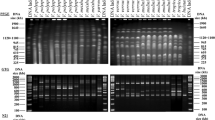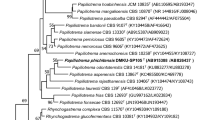Abstract
Three strains originating from insect frass in South Africa, yellow foxglove in Hungary and soil in France, were characterised phenotypically and by sequencing of the D1/D2 domain of the large subunit and the ITS1-5.8S-ITS2 (ITS)-region of the rRNA gene. The strains have identical D1/D2 domain sequences and only one strain shows a 1 bp indel in a 9 bp homopolymer A/T repeat within the ITS-region. Based on sequence analysis Hyphopichia burtonii is the closest related species. The investigated strains differ from the type strain of H. burtonii by 1.9% (9 substitutions and an indel) in the D1/D2 domain and by 23 substitutions and 21–22 indels in the ITS-region. Since the sequence variability is very low among the three strains and the sequence divergence with the closely related H. burtonii exceeds the level generally encountered between species we propose the new species Hyphopichia lachancei f.a., sp. nov. to accommodate the three novel strains. From H. burtonii the new species can be distinguished phenotypically by its inability to ferment cellobiose and by the formation of endospores (Holotype: CBS 5999T; Isotype: NCAIM Y.02228T; MycoBank no.: MB833616).


Similar content being viewed by others
References
Alper I, Frenette M, Labrie S (2011) Ribosomal DNA polymorphisms in the yeast Geotrichum candidum. Fungal Biol 115:1259–1269
Barnett JA, Payne RW, Yarrow D (2000) Yeasts: characteristics and identification, 3rd edn. Cambridge University Press, Cambridge
Brysch-Herzberg M, Seidel M (2015) Yeast diversity on grapes in two German wine growing regions. Int J Food Microbiol 214:137–144. https://doi.org/10.1016/j.ijfoodmicro.2015.07.034
Gouy M, Guindon S, Gascuel O (2010) SeaView version 4: a multiplatform graphical user interface for sequence alignment and phylogenetic tree building. Mol Biol Evol 27:221–224
Groenewald M, Smith MT (2010) Re-examination of strains formerly assigned to Hyphopichia burtonii, the phylogeny of the genus Hyphopichia, and the description of Hyphopichia pseudoburtonii sp. nov. Int J Syst Evol Microbiol 60:2675–2680
Kurtzman C (1998) Pichia EC Hansen emend. Kurtzman. In: Kurtzman CP, Fell JW (eds) The yeasts. Elsevier, Amsterdam, pp 273–352
Kurtzman CP (2005) New species and a new combination in the Hyphopichia and Yarrowia yeast clades. Antonie Van Leeuwenhoek 88:121–130
Kurtzman CP (2011) Hyphopichia von Arx & van der Walt (1976). In: Kurtzman CP, Fell JW, Boekhout T (eds) The yeasts: a taxonomic study, 5th edn. San Diego, Elsevier Science Imprint, Elsevier Science & Technology Books, pp 435–438
Kurtzman CP, Robnett CJ (1998) Identification and phylogeny of ascomycetous yeasts from analysis of nuclear large subunit (26S) ribosomal DNA partial sequences. Antonie Van Leeuwenhoek 73:331–371
Kurtzman CP, Fell JW, Boekhout T (2011) Methods for isolation, phenotypic characterization and maintenance of yeasts. In: Kurtzman CP, Fell JW, Boekhout T (eds) The yeasts: a taxonomic study, 5th edn. Elsevier Science Imprint, Elsevier Science & Technology Books, San Diego, pp 21–30
Lachance M-A (2018) CP Kurtzman’s evolving concepts of species, genus and higher categories. FEMS Yeast Res. https://doi.org/10.1093/femsyr/foy103
Lachance MA, Daniel H-M, Meyer W, Prasad GS, Gautam SP, Boundy-Mills K (2003) The D1/D2 domain of the large-subunit rDNA of the yeast species Clavispora lusitaniae is unusually polymorphic. FEMS Yeast Res 4:253–258
Limtong S, Kaewwichian R, Jindamorakot S, Yongmanitchai W, Nakase T (2012) Candida wangnamkhiaoensis sp. nov., an anamorphic yeast species in the Hyphopichia clade isolated in Thailand. Antonie Van Leeuwenhoek 102:23–28
Ren Y-C, Liu S-T, Li Y, Hui F-L (2015) Pichia dushanensis sp. nov. and Hyphopichia paragotoi sp. nov., two sexual yeast species associated with insects and rotten wood. Int J Syst Evol Microbiol 65:2875–2881
Ribeiro LR, Santos ARO, Groenewald M, Smith MTH, Lara CA, Góes-Neto A, Jacques N, Grondin C, Casaregola S, Lachance M-A, Rosa CA (2017) Description of Hyphopichia buzzinii f.a., sp. nov. and Hyphopichia homilentoma comb. nov., the teleomorph of Candida homilentoma. Antonie Van Leeuwenhoek 110:985–994
Sipiczki M, Horvath E, Pfliegler WP (2018) Birth-and-death evolution and reticulation of ITS segments of Metschnikowia andauensis and Metschnikowia fructicola rDNA repeats. Front Microbiol 9:1193
von Arx J, Van der Walt J (1976) The ascigerous state of Candida chodatii. Antonie Van Leeuwenhoek 42:309–314
Vu D et al (2016) DNA barcoding analysis of more than 9 000 yeast isolates contributes to quantitative thresholds for yeast species and genera delimitation. Stud Mycol 85:91–105
White TJ, Bruns TD, Lee S, Taylor J (1990) Amplification and direct sequencing of fungal ribosomal RNA genes for phylogenetics. In: Innis M, Gelfand D, Sninsky J, White T (eds) PCR protocols: a guide to methods and applications. Academic Press, London, pp 315–322
Wu Z-W, Bai F-Y (2005) Kazachstania aquatica sp. nov. and Kazachstania solicola sp. nov., novel ascomycetous yeast species. Int J Syst Evol Microbiol 55:2219–2224
Yamada Y, Higashi T, Mikata K (1999) The phylogeny of species of the ascogenous teleomorphic yeast genera Ambrosiozyma, Hormoascus, Hyphopichia, Arthroascus, and Botryoascus based on the partial sequences of 18S and 26S ribosomal RNAs. Bull Fac Agric-Shizuoka Univ (Jpn) 48:1–13
Acknowledgements
This work was supported by The Deutsche Bundesstiftung Umwelt DBU (German Federal Environmental Foundation) [34053/01-32 to M.B-H] and by the State Secretariat for Education of the Hungarian Ministry of Human Capacities and by the European Union and co-financed by the European Social Fund [grant agreement no. EFOP-3.6.3-VEKOP-16-2017-00005 to G.P. and D.D.].
Author information
Authors and Affiliations
Contributions
MBH wrote parts of the paper, produced the figures, analysed data and performed the light microscopic analysis. MG wrote parts of the paper, made physiological tests and supported the data analysis. DD and MS performed physiological tests and did molecular genetic analysis. GP wrote parts of the paper.
Corresponding author
Ethics declarations
Conflict of interest
The authors declare that they have no conflict of interest.
Additional information
Publisher's Note
Springer Nature remains neutral with regard to jurisdictional claims in published maps and institutional affiliations.
Rights and permissions
About this article
Cite this article
Brysch-Herzberg, M., Groenewald, M., Dlauchy, D. et al. Hyphopichia lachancei, f.a., sp. nov., a yeast species from diverse origins. Antonie van Leeuwenhoek 113, 773–778 (2020). https://doi.org/10.1007/s10482-020-01387-5
Received:
Accepted:
Published:
Issue Date:
DOI: https://doi.org/10.1007/s10482-020-01387-5




